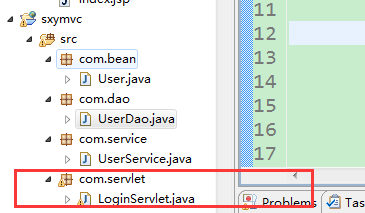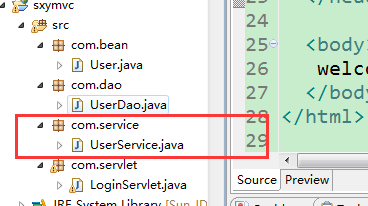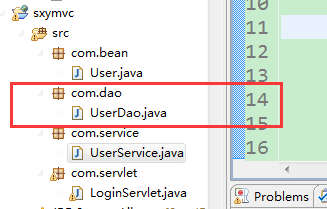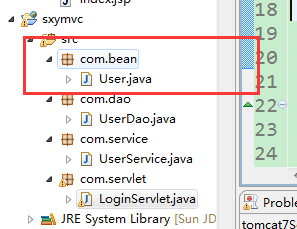sxymvc
1.login.jsp
1 <%@ page language="java" import="java.util.*" pageEncoding="utf-8"%> 2 <% 3 String path = request.getContextPath(); 4 String basePath = request.getScheme()+"://"+request.getServerName()+":"+request.getServerPort()+path+"/"; 5 %> 6 7 <!DOCTYPE HTML PUBLIC "-//W3C//DTD HTML 4.01 Transitional//EN"> 8 <html> 9 <head> 10 <base href="<%=basePath%>"> 11 12 <title>My JSP 'login.jsp' starting page</title> 13 14 <meta http-equiv="pragma" content="no-cache"> 15 <meta http-equiv="cache-control" content="no-cache"> 16 <meta http-equiv="expires" content="0"> 17 <meta http-equiv="keywords" content="keyword1,keyword2,keyword3"> 18 <meta http-equiv="description" content="This is my page"> 19 <!-- 20 <link rel="stylesheet" type="text/css" href="styles.css"> 21 --> 22 23 </head> 24 25 <body> 26 <form action="LoginServlet" method="post"> 27 <table> 28 <tr> 29 <td>用户名 :</td> 30 <td><input type="text" name="username"> 31 </td> 32 </tr> 33 <tr> 34 <td>密码 :</td> 35 <td><input type="text" name="password"> 36 </td> 37 </tr> 38 <tr> 39 <td colspan="2"><input type="submit" value="提交"></td> 40 </tr> 41 </table> 42 </form> 43 </body> 44 </html>
2.welcome.jsp
1 <%@ page language="java" import="java.util.*" pageEncoding="utf-8"%> 2 <% 3 String path = request.getContextPath(); 4 String basePath = request.getScheme()+"://"+request.getServerName()+":"+request.getServerPort()+path+"/"; 5 %> 6 7 <!DOCTYPE HTML PUBLIC "-//W3C//DTD HTML 4.01 Transitional//EN"> 8 <html> 9 <head> 10 <base href="<%=basePath%>"> 11 12 <title>My JSP 'weclome.jsp' starting page</title> 13 14 <meta http-equiv="pragma" content="no-cache"> 15 <meta http-equiv="cache-control" content="no-cache"> 16 <meta http-equiv="expires" content="0"> 17 <meta http-equiv="keywords" content="keyword1,keyword2,keyword3"> 18 <meta http-equiv="description" content="This is my page"> 19 <!-- 20 <link rel="stylesheet" type="text/css" href="styles.css"> 21 --> 22 23 </head> 24 25 <body> 26 welcome my friend <B>${username}</B> ! <br> 27 </body> 28 </html>
3.UserServlet

1 package com.servlet; 2 3 import java.io.IOException; 4 import java.io.PrintWriter; 5 6 import javax.servlet.ServletException; 7 import javax.servlet.http.HttpServlet; 8 import javax.servlet.http.HttpServletRequest; 9 import javax.servlet.http.HttpServletResponse; 10 11 import com.bean.User; 12 import com.service.UserService; 13 14 public class LoginServlet extends HttpServlet { 15 16 public void doGet(HttpServletRequest request, HttpServletResponse response) 17 throws ServletException, IOException { 18 19 doPost(request,response); 20 } 21 22 public void doPost(HttpServletRequest request, HttpServletResponse response) 23 throws ServletException, IOException { 24 25 String username = request.getParameter("username"); 26 String password = request.getParameter("password"); 27 28 User user = new User(); 29 user.setUsername(username); 30 user.setPassword(password); 31 32 //调用service进行业务逻辑处理 33 UserService userService = new UserService(); 34 boolean isExist = userService.getUser(user); 35 36 if(isExist){ 37 request.setAttribute("username",username); 38 request.getRequestDispatcher("jsp/weclome.jsp").forward(request, response); 39 }else{ 40 request.getRequestDispatcher("jsp/login.jsp").forward(request, response); 41 } 42 } 43 44 45 }
4.UserService.java

1 package com.service; 2 3 import com.bean.User; 4 import com.dao.UserDao; 5 6 7 public class UserService { 8 9 public boolean getUser(User user){ 10 //查询数据库user对象是否存在 11 UserDao userdao= new UserDao(); 12 //去数据库查询user是否存在 13 return userdao.getUser(user); 14 15 16 } 17 18 19 }
5.UserDao.java

1 package com.dao; 2 3 import java.sql.*; 4 5 import com.bean.User; 6 7 public class UserDao { 8 9 public boolean getUser(User user){ 10 boolean isExist=false; 11 Connection coon=null; 12 Statement sta = null; 13 ResultSet re = null; 14 String url="jdbc:oracle:thin:@localhost:1521:inspur"; 15 String name="scott"; 16 String pass="tiger"; 17 try { 18 19 //加载驱动 20 Class.forName("oracle.jdbc.driver.OracleDriver"); 21 //建立连接 22 coon=DriverManager.getConnection(url,name,pass); 23 //创建Statement对象,执行sql 24 sta=coon.createStatement(); 25 String sql="select * from loginuser where username = '"+user.getUsername()+"' and password ='"+user.getPassword()+"'"; 26 re=sta.executeQuery(sql); 27 //处理结果 28 if(re.next()){ 29 isExist=true; 30 } 31 //释放资源 32 re.close(); 33 sta.close(); 34 coon.close(); 35 36 } catch (Exception e) { 37 // TODO: handle exception 38 e.printStackTrace(); 39 } 40 41 return isExist; 42 } 43 44 }
6.User.java

1 package com.bean; 2 3 public class User { 4 private String username; 5 private String password; 6 public String getUsername() { 7 return username; 8 } 9 public void setUsername(String username) { 10 this.username = username; 11 } 12 public String getPassword() { 13 return password; 14 } 15 public void setPassword(String password) { 16 this.password = password; 17 } 18 19 20 }




 浙公网安备 33010602011771号
浙公网安备 33010602011771号